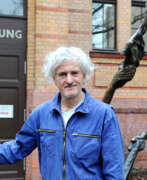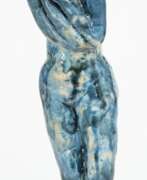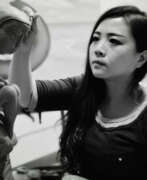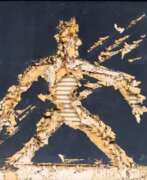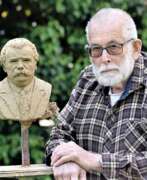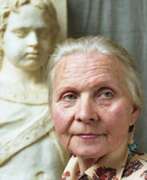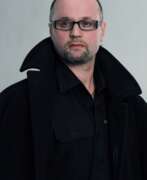Portrait sculpture Contemporary art


Fanizani Akuda is a self-taught sculptor from Zimbabwe, born in Zambia.
He was working as a stonemason in a quarry when he got his hands on a tool and created his first stone sculpture. With his own unique style, Fanizani was able to convey human emotion in stone with talent. His work can be recognized by the slitted eyes, rounded shapes, cheerful and smiling faces, and his themes are also happy families, human and animal interactions, often in pairs or groups. Fanizani also liked to carve whistle sculptures.
Thanks to Fanizani and his unique stone sculptures, Zimbabwe is internationally recognized today.


Harold Ambellan is an American painter and sculptor.
He studied sculpture and fine art in Buffalo before moving to New York City. The human figure is central to Harold Ambellan's work. He created monumental figures and drew extensively, leaving thousands of drawings. Ambellan was one of the participants in Roosevelt's Federal Art Project, which hired hundreds of artists during the Great Depression who collectively created more than 100,000 paintings and over 18,000 sculptures.
Ambellan remained committed to figuration in both his sculpture and painting. He was elected president of the Sculptors Guild of America in 1941, and that same year his work was exhibited in group shows at the Metropolitan Museum of Art in New York and the Academy of Fine Arts in Philadelphia.
In 1944, Ambellan participated in the liberation of Normandy as part of the U.S. Navy, then taught three-dimensional art at the Workshop School in New York City. In 1954, for political reasons, Ambellan moved to France and remained there for the rest of his life, working and exhibiting throughout Europe.


Aslan, real name Alain Gourdon, French artist, illustrator and sculptor. He is best known in France for his pin-up work. He studied at the Ecole Nationale des Beaux-Arts in Paris.
Aslan was also the author of busts and statues of many famous people (actors, politicians, singers). His works are often characterised by grace, courage and ardour. Aslan masterfully conveys the beauty and emotional depth of the female body, playing with lines, shapes and light. His compositions often evoke mixed feelings: they are both elegant and provocative, evoking a dialogue between eroticism and art.
Aslan's work has a surreal element to it, lending an air of mystery and singularity to his work. He combines reality and fantasy with ease, creating a world full of unpredictable and mystical images.


Edgar Augustin was a German painter and sculptor.
Augustin studied sculpture in Münster with Karl Ehlers, then was a pupil of the master Gustav Zeitz in Hamburg. His oeuvre includes partly abstract figurative representations in bronze, wood and plaster as well as paintings, drawings and graphics. Some of Edgar Augustine's sculptures are located in public spaces in Hamburg and other cities.
Edgar Augustin was a member of the Free Academy of Arts in Hamburg and the Special Association of Artists in Germany. In the second half of the 20th century, Augustin was one of the pioneers of figurative wood sculpture and is considered its most important representative.


Robert Petrosovich Avakyan (Russian: Роберт Петросович Авакян) was a Soviet and Uzbek artist of the second half of the twentieth and early twenty-first centuries of Armenian origin. He is known as a painter, graphic artist, sculptor and teacher.
Robert Avakyan was trained in painting, but he is most famous as an author of monumental sculptures. He worked actively in Tashkent, participating in numerous exhibitions, including international sculpture competitions. The master also left his mark in such Uzbek cities as Bukhara, Nukus and Yangibazar, where he created significant monumental works.


Elfriede Balzar-Kopp is a German ceramic artist.
She trained at the state ceramics engineering workshop in Höhr, worked in Karlsruhe at the State Maiolica Manufactory, and founded her own pottery workshop in Höhr in 1927.
Elfriede Balzar-Kopp initially focused on local Baroque vessels in her work and combined them with other styles. Her unique ceramic animal figurines, jugs, and genre scenes are sought after by collectors, and many of the objects she created adorn galleries around the world. Her son Heiner Balzar (born 1937) is one of the outstanding ceramic artists of the second half of the 20th century.
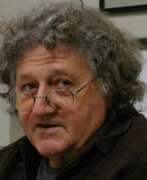

Bruno Bruni senior is an Italian lithographer, graphic artist, painter and sculptor. He became commercially successful in the 1970s. In 1977, he won the International Senefeld award for Lithography. He has since become one of the most successful Italian artists in Germany and one of Germany's best known lithographers.


Carmen Calvo, full name Carmen Calvo Sáenz de Tejada, is a Spanish conceptual artist and sculptor.
Carmen Calvo is one of the most representative Spanish conceptual artists of our time. She studied at the School of Arts and Crafts and then at the School of Fine Arts of Valencia, worked in a ceramic factory and since then always incorporates fired clay in her plastic compositions. The artist also works in scenography using photography and other, very diverse formal, technical and thematic resources.
In 2013, Carmen Calvo was awarded the National Award for Plastic Arts by the Ministry of Education, Culture and Sport, and in 2014 she was appointed Academician of the Royal Academy of Fine Arts of San Carlos de Valencia.


Terence Carr is a German painter and sculptor originally from Kenya.
Terence Carr, whose family emigrated to Africa from Ireland, was born in Nairobi, Kenya, where he spent the first 19 years of his life. In 1971, he traveled to England, where he became an officer in the British Army and then served in Germany. After gaining life experience, Carr enrolled at Augsburg University to study art education.
There is always an African influence in Carr's wooden sculptures, his peculiar language of forms. The artist hardly makes any sketches and immediately works directly on the wood with a chainsaw. Terence Carr uses constantly recurring symbols that reflect opposites - good and evil, love and hate, war and peace, pain, fear, suffering, tolerance and humanity. Animals with human features and people who look animal-like. Overall, it touches on the root issues of being human.
Over time, Terence Carr has become one of the most famous artists in the world. His works can be seen at exhibitions in different parts of the world and are represented in many significant collections.


Alfred Dade is an Albanian painter and sculptor working in Germany.
Dade studied at the Art Academy in Rome with Prof. Marchese and at the Art Academy in Düsseldorf with Prof. Markus Lüpertz. Since 1999 he has been working as a freelance artist in Mülheim/Ruhr, creating sculptures in wood.


John Stuart Dowie was an Australian painter, sculptor and teacher.
His work includes over 50 public sculpture commissions, including the "Three Rivers" fountain in Victoria Square, "Alice" in Rymill Park, the "Victor Richardson Gates" at Adelaide Oval and the "Sir Ross & Sir Keith Smith Memorial" at Adelaide Airport. He was nominated for Senior Australian of the Year in 2005, and was made a Member of the Order of Australia in 1981 in recognition of service to the arts as a sculptor and painter.


Thomas Duttenhoefer was a German sculptor, draughtsman, graphic artist, and illustrator, and professor at the University of Mannheim.
In addition to his human figures, Thomas Duttenhoefer's figurative work includes many depictions of animals in a deliberately crude manner.
He is a member of the New Darmstadt Secession, the Palatinate Secession and the Argo Group, Speyer.


Ed Dwight, full name Edward Joseph Dwight Jr. is an American sculptor, writer, and former test pilot.
He was the first African-American to enter the Air Force training program from which NASA selected astronauts. He resigned from the Air Force in 1966 for reasons of racial discrimination, politics and bureaucracy and turned to the arts. Dwight earned a Master of Fine Arts degree in sculpture from the University of Denver in 1977 and excelled as an artist. Most of Dwight's work depicts only black people, and his acclaimed series Jazz: The Shape of American Art focuses on the evolution of jazz and includes all iconic jazz performers.
Ed Dwight has had a thriving career in sculpture and has many high-profile projects to his credit. His unique masterpieces are displayed in several memorials across the United States. He has also become a historian and writer.


Nicole Eisenman is French-born American artist known for her oil paintings and sculptures. She has been awarded the Guggenheim Fellowship (1996), the Carnegie Prize (2013), and has thrice been included in the Whitney Biennial (1995, 2012, 2019). On September 29, 2015, she won a MacArthur Fellowship award for "restoring the representation of the human form a cultural significance that had waned during the ascendancy of abstraction in the 20th century."


Ellen Kristina Abelli Elander is a Swedish artist, illustrator and sculptor.
She was educated at Birkagårdens folkhögskola and at the beginning of her artistic journey she was interested in the monstrous and the morbid, the grotesque and the cannibalistic. Later on the figure of the Alien appears and becomes central in Elander's works, participating in human life in one way or another.
The artist uses painting, drawing, textile sculpture and ceramics to express her ideas, creates spatial installations, and also draws comics.


Heinrich Faltermeier was a German sculptor. After an apprenticeship as a goldsmith and years of travel, including to Spain, Faltermeier studied from 1936 to 1943 at the Academy of Fine Arts in Munich. He worked in accordance with the Nazi concept of art and created war memorials. From 1938 to 1944, with the exception of 1941, he was represented at all major German art exhibitions. Faltermeier's preferred working materials as a sculptor were bronze, marble and wood.


Michel Favre is a Swiss painter and sculptor living and working in Martigny.
Michel trained as a marble sculptor from a young age: learning to work with materials, honing his craft and technical skills, and practicing restoration. In 1972 he opened his atelier in Martigny and until 1980 he created almost exclusively stone sculptures, but since the 1990s he has incorporated bronze, glass and other materials into his work. Since 1996 he has also created video installations, combining plastic arts, film, photography and new media. Michel Favre travels extensively and is passionate about archaeology.
The main motif of the sculptor's works is the fragile human being in a looming world of machines and technology. In his three-dimensional images, people are most often tiny and ant-like, trying to change something in the huge world around them.
Michel Favre has been a member of VISARTE (Society of Swiss Artists, Sculptors, Architects) since 1983 and has been active in numerous exhibitions around the world.


Rainer Fetting is a German painter and sculptor.
Rainer Fetting was one of the co-founders and main protagonists of the Galerie am Moritzplatz in Berlin, founded in the late 1970s by a group of young artists (mainly painters) from the class of Karl Horst Hödicke at the former Berliner Hochschule für Bildende Künste (Berlin Art Academy, today known as Universität der Künste). Fetting is now one of the internationally best known contemporary German artists, having created a large oeuvre of expressive figurative paintings covering many different kinds of subject-matter, as well as many bronze sculptures.
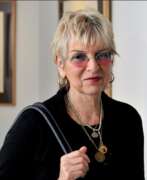

Audrey L. Flack is an American artist. Her work pioneered the art genre of photorealism and encompasses painting, sculpture, and photography. Flack's early work in the 1950s was abstract expressionist. But gradually, Flack became a New Realist and then evolved into photorealism during the 1960s. Audrey Flack is best known for her photo-realist paintings and was one of the first artists to use photographs as the basis for painting.[6] The genre, taking its cues from Pop Art, incorporates depictions of the real and the regular, from advertisements to cars to cosmetics. Flack's work brings in everyday household items like tubes of lipstick, perfume bottles, Hispanic Madonnas, and fruit.[6] These inanimate objects often disturb or crowd the pictorial space, which are often composed as table-top still lives. Flack often brings in actual accounts of history into her photorealist paintings, such as World War II' (Vanitas) and Kennedy Motorcade. Women were frequently the subject of her photo-realist paintings. She was the first photorealist painter to be added to the collection of the Museum of Modern Art in 1966.


Fritz Fleer is a German painter and sculptor. He studied at the Hamburg University of Fine Arts in the class of Edwin Paul Scharf.
As independent artist, Fritz Fleer has been creating works for urban planning since the 1950s; in Hamburg he was commissioned for 17 sculptures by the municipal housing company SAGA.


Alison Erika Forde is a British artist who often uses old, discarded objects, prints, household wood in her art. She transforms these unnecessary things into imaginary fragments of dreams and illusions. The artist creates vibrant multi-dimensional art that includes sculpture, paint, and performance art.


Werner Franzen is a German sculptor known for his sculptural compositions in public spaces.
His works are made very simply, but they are very attractive and human. Franzen's sculptures do not break up interiors or landscapes, but blend in very organically, complementing them and creating a cozy atmosphere.


Katharina Fritsch is a German sculptor who lives and works in Düsseldorf, Germany.
She studied at the Düsseldorf Academy of Art and became known for her iconic and unusual sculptures and installations.
Fritsch's work often evokes disturbing religious or quasi-spiritual associations and is deeply psychological, as if she were trying to give an image to our deepest fears, extracted from the world of myth, religion, cultural history and everyday life. One of her most impressive works, Rat King (1993), is a circle of sixteen giant rats, each nearly ten feet tall, with their tails tied in a massive knot in the center.


Emilio Greco was an Italian realist sculptor, draftsman, writer and poet.
At the age of 13, Greco was apprenticed to a mason and later studied at the Academy of Fine Arts in Palermo. His first solo exhibition took place in 1946. Emilio Greco created monumental figurative works in bronze and marble, park sculptures, primarily nude female figures and portraits. His sculptures are characterized by refined, elongated forms in the tradition of Italian mannerism. Notable among them is the monument to the character Pinocchio (Pinocchio and the Fairy) for the town of Collodi.
Greco also designed one of the bronze doors of the cathedral in Orvieto and the monument to Pope John XXIII in St. Peter's Basilica. In 1974, a Greco Garden dedicated to his works was opened at the Open Air Museum in Hakone, Japan.


Sabina Grzimek (German: Sabina Grzimek) is a German sculptor.
Sabina is the daughter of sculptor Waldemar Grzimek (1918-1984) and artist and ceramist Christa von Karnap. She apprenticed at the Meissen porcelain manufactory, then studied sculpture in Berlin. Sabina Grzimek created a large number of bronze, plaster, terracotta and clay sculptures, some of which are placed in public spaces in European cities.




Anneliese Henecka is a German artist, draftsman and sculptor.
She studied architecture and free sculpture at the Dusseldorf Academy of Art, and has worked in the United States, Great Britain, Italy, and Russia.
Anneliese Henecka has created many sculptural works, including fountains, large-scale bas-reliefs in bronze and concrete, marble, bronze and wooden sculptures and portraits, and ivory relief sculptures.




Peter Hohberger is a German actor, painter, and modernist sculptor.
He is considered one of the sculptors of the "New School" artistic movement that developed in France after 1945. Hohberger's exquisite sculptures of female nudes are a success and are found in many collections around the world.


Karl Holmqvist is a Swedish artist known for his text based works, poetry and readings. Holmqvist has exhibited at the ICA — Institute of Contemporary Arts 2009, CAM — Chelsea Art Museum, 2009, The Living Art Museum, Reykjavik (2008), Tensta Konsthall (2008) Manifesta 7 — Comitato Manifesta 7, Bolzano (2008) and at PERFORMA 05 — Performa, New York City, NY (2005).


Stanisław Horno-Poplawski was a Polish sculptor, artist and teacher.
In the late 1910s, young Stanisław became interested in painting and art in Moscow, where his family moved from Georgia, then continued his studies at the Warsaw School of Fine Arts. Stanisław Gorno-Poplawski made the subject of his sculpture a rough field stone, giving it the features of famous and unknown Poles' faces, creating compositions filled with life. His works can be seen in many museums in Poland and the world.


Sjer Jacobs is a Dutch painter and sculptor.
Jacobs creates sculptures in ceramics, bronze, iron, Corten steel, copper, glass and stone, paintings on canvas and stainless steel plates, wire figures, steel and iron panels and screen prints.... All his works are about people in ordinary life: his men and women, like everyone else, waiting in the reception area of an office building, sitting on a park bench or walking down a shopping street, meeting for drinks, music and conversation. These people are close to everyone.
Sjer Jacobs' larger ceramic and bronze works are always one-of-a-kind, while smaller ones are often produced in editions, but even so, each sculpture is unique.
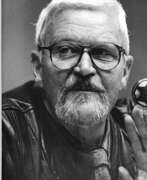

Jo Jastram, born Joachim Jastram, is a German sculptor.
Jastram studied at the Dresden University of Fine Arts and then at the University of Fine and Applied Arts in Berlin-Weißensee, earning a degree in sculpture. Later he taught himself at several universities and was a member of various state and public cultural associations. The sculptor was repeatedly awarded the Art Prize of the GDR.
Jo Jastram created an extensive collection of portraits during his long life, as well as many diverse compositions and sculptures in public spaces. Some of his most famous works are the "Fountain of the Joy of Life" on University Square in Rostock, created in 1978 in collaboration with Reinhard Dietrich, as well as "The Great African Journey" (1983), installed in Rostock's city harbor in 2008.
Jo Jastram's three sons Matthias, Michael, Jan Jastram and daughter Susanne Rast became painters and sculptors, and the sculptor Thomas Jastram is his nephew.


Nida Kadhim is an Iraqi sculptor, noted for producing a number of monumental works for Baghdad's city centre, some of which are still standing, while others were demolished or looted following the 2003 Iraqi invasion. Kadhim received his formal art education at Baghdad's Academy of Fine Arts in the 1950s. Actively involved in the Iraqi arts community, he became a founding member of the art group known as Al-Mujadidin (The Innovationists). His sculptures focus on grandiose busts and statues of leading figures taken from Iraq's history, or are based on other themes the artist considers worthy. His most well-known sculpture, which is still standing, is the Arab Woman in Zawra Park, Baghdad. It depicts an Arab woman holding a bouquet of flowers out to the new generation of Iraqis who are seeking a better future.


Funakoshi Katsura is a Japanese sculptor and one of Japan's leading figures in the visual arts. His woodwork, usually depicting human figures above the waist, is striking and distinctive. Funakoshi processes the material, leaving the structure of the wood and traces of the carvings visible. The artist carefully uses grit for modeling and leaves unpainted part of the figure's head.


Alexey Nikanorovich Komarov (Russian: Алексей Никанорович Комаров) was a Russian and Soviet artist of the twentieth century. He is known as a painter, sculptor and animalist.
Alexey Komarov became famous for his illustrations in children's books and graphic works. His works cover a variety of subjects, from landscapes to animals. He has also created posters on a variety of subjects, including children's health care and the defense of the homeland during World War II. Komarov is also known for his watercolors as well as his sculptural works, including animal figures and busts. His works decorate various museums and exhibition pavilions.
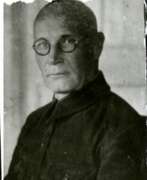

Georgy Dmitrievich Lavrov (Russian: Георгий Дмитриевич Лавров) was a Russian and Soviet sculptor of the twentieth century. He is known as a portraitist, monumentalist, animalist and representative of the Art Deco style.
Georgy Lavrov created propaganda posters at the beginning of his career in collaboration with poet Vladimir Mayakovsky. He then developed his style during a business trip to Paris under the influence of the French animalist sculptor François Pompon. Returning from France in 1935, he created the famous sculptural composition "Thank you Comrade Stalin for our happy childhood!". However, in 1938 the artist was arrested and convicted, served his sentence in the camps, and in 1954 was rehabilitated.
Lavrov left a significant artistic legacy.


Peter Leisinger is a Swiss painter and sculptor.
Leisinger's favorite material for his work is wood. The artist enjoys the variability of wood and its susceptibility to craftsmanship. He also develops subjects and concepts for exhibitions, installations, books and films.


Richard Mteki is a Zimbabwean sculptor and master stone carver.
Influenced by his older brother, sculptor Boira, he began sculpting at the Nyarutsezo Art Center in the 1960s. And Richard is considered one of Zimbabwe's most successful artists. The power and fluidity of the lines of his unique sculptures demonstrate his remarkable talent.
Mteki is a first-generation sculptor who draws most of his work from the beliefs of the Shona people, although he is also inspired by nature, depicting animals in his own unique style. For Mteki, the form of raw stone is important, and he prefers to work with the stone rather than impose his will on it.


Carlos García Muela is a Spanish sculptor.
Carlos Muela studied at the National School of Fine Arts in Tetouan, Spanish protectorate of Morocco, he moved to Madrid in 1974.
His first sculptures were made of sandstone and were rather crude. Later he began to create more expressionist works in iron or bronze. In 1970, Muela began his series of Torsos of classical character, which became the basis of his work. The sculptor achieved highly expressive figures by breaking and layering them. This was achieved by spreading layers of wax, which broke at the moment of casting in bronze, thus enhancing the effect of the passage of time on the sculptural object.


Berthold Müller-Oerlinghausen, born Berthold Müller, is a German sculptor, painter, designer and mosaic artist.
Berthold studied architecture at the Technical University of Berlin, then worked for a time in the artistic decoration of churches. He was fascinated by Italian and Mediterranean art and built on this fascination.
In 1936 Müller-Oerlinghausen founded a mosaic workshop in Berlin, which was destroyed by bombing in 1944, but in 1946 he rebuilt it and began a new period in his work. This workshop produced, among other things, elegant mosaic coffee tables, which are sought after by collectors.


Henry Munyaradzi, known simply as Henry, is a self-taught Zimbabwean sculptor, a representative of "shona sculpture.
Before he got his hands on an instrument, Henry was a common laborer and never attended school. His sculptural work combines the simplicity of the primitive with stylized sophistication. He has great respect for the stone he uses and is often inspired by the original form. Henry has achieved outstanding success internationally, holding individual and group exhibitions around the world.


Hermann Naumann, a distinguished German artist, has made significant contributions to the fields of painting, graphics, illustration, and sculpture. Starting his artistic journey with a stonemasonry apprenticeship, Hermann Naumann later honed his skills in sculpture under the guidance of Burkhart Ebe and Herbert Volwahsen at the HBK Dresden. Over time, he expanded his artistic repertoire to include painting and graphic arts, embracing techniques like lithography, etching, and punch cutting.
Hermann Naumann's works are celebrated for their depth and versatility, reflecting his mastery over various mediums. Notably, his illustrations for literary works, such as Heinrich Böll's "Erzählungen" and Franz Kafka's "Betrachtung," showcase his exceptional ability to complement and elevate textual narratives through visual art. His public sculptures, like the relief in Dresden and the "Fahnenschwinger" in Riesa, further attest to his prowess in creating engaging and meaningful art.
For art collectors and enthusiasts, Hermann Naumann's oeuvre offers a rich tapestry of visual narratives, each piece echoing the artist's profound engagement with his subjects and mediums. Those interested in exploring Hermann Naumann's artistic journey and his contributions to German art and culture are encouraged to stay updated on exhibitions, sales, and auctions featuring his work.


Joseph Ndandarika is a Zimbabwean sculptor known for his figurative works.
At first he specialized in pictorial landscapes and witchcraft scenes. In 1962, Ndandarika became known for his work Bushmen Running from the Rain. Gradually he switched to stone sculpture, depicting mainly domestic scenes. During the Zimbabwean art revival of the 1980s he was one of the country's first prominent sculptors.


Manuel John Neri the Younger was an American sculptor who is recognized for his life-size figurative sculptures in plaster, bronze, and marble. In Neri's work with the figure, he conveys an emotional inner state that is revealed through body language and gesture. Since 1965 his studio was in Benicia, California; in 1981 he purchased a studio in Carrara, Italy, for working in marble. Over four decades, beginning in the early 1970s, Neri worked primarily with the same model, Mary Julia Klimenko, creating drawings and sculptures that merge contemporary concerns with Modernist sculptural forms.


Nikolai Bagratovich Nikoghosyan (Russian: Николай Багратович Никогосян) was a Soviet Armenian sculptor and artist, celebrated for his mastery in creating expressive portraits and monumental sculptures that capture the essence and vitality of his subjects. Born in 1918, Nikoghosyan's art was significantly influenced by the Russian school of realistic sculpture and the national plastics of Armenia, reflecting a unique blend of cultural heritage and artistic innovation.
Throughout his remarkably long career, Nikoghosyan created a vast array of works, including over 200 busts in bronze, wood, and marble, 600 oil paintings, and 3,000 charcoal drawings. His artworks are appreciated worldwide, held in private collections across countries like France, Belgium, and Italy.
Nikoghosyan's significant contributions to art were recognized with numerous titles, including the People's Artist of the Armenian SSR, People's Artist of the USSR, and laureate of the USSR State Prize. His legacy is preserved and celebrated at the Nikoghosyan Cultural Foundation in Yerevan, Armenia, which showcases his sculptures, graphics, and paintings. The foundation not only serves as a tribute to Nikoghosyan's memory but also aims to inspire and support young Armenian artists.
For art enthusiasts and collectors, the work of Nikolai Bagratovich Nikoghosyan offers a fascinating glimpse into the blend of Armenian tradition and Soviet-era artistic expression, making his pieces highly sought after in the realms of both national and international art collections. To stay updated on exhibitions and auction events featuring Nikoghosyan's work, signing up for updates is highly recommended. This ensures you remain informed about opportunities to appreciate or acquire pieces by this master sculptor and artist.














